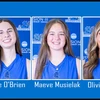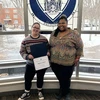Alumni from all across the country who studied one of the Geosciences at SUNY Fredonia will return to campus during Homecoming weekend, Oct. 11 to 13, to celebrate that department’s 50th anniversary. Reminiscing with former classmates and professors, enjoying a buffet dinner, meeting current students and perhaps embarking on a field trip to an area of prime geological interest in Chautauqua County are on the agenda.
SUNY Fredonia President Virginia Horvath will welcome alumni and friends, and present the department’s annual student awards at the dinner on Saturday night in Houghton Hall’s first floor lounge. Festivities begin with a social hour at 6 p.m., followed by the buffet featuring Western New York fare (chicken wings, beef on ‘weck, nachos, potato skins) along with desserts and coffee and tea, at 7 p.m. The program is set to start at 7:45 p.m. Tickets to the dinner are $18 and will be available at the door.
Dr. Gordon Baird, department chair, will emcee the evening. Highlights of those five decades will be revisited through a wide range of memorabilia. Photographs of student field trips at national parks, maps, geological specimens, newspaper and magazine clippings and other items chronicle a wide array of student and faculty achievements. One of the earliest photos shows the department’s original faculty members on the steps of the College Lodge. Slides of department activities will also be shown continuously on two projectors and video monitor.
Many items on display were offered by Distinguished Teaching Professor Richard Gilman, a retired faculty member who joined the fledgling department in 1964, its second year. Gilman went on to lead eight student field trips to national parks during his tenure. Tom Erlandson of Jamestown Community College, former SUNY Fredonia Admissions Director Bill Clark, and John Malcolm, former chair of the SUNY Fredonia Communication Department, were co-leaders on some of these excursions.
Alumni have also been invited to bring maps, specimens – any sort of memorabilia they may have – to the celebration. “Some of the memorabilia will be brought spontaneously,” Dr. Michael Wilson said. With 60 years of combined service to the department, Baird and Wilson are ideally suited to organize the celebration.
Baird and several other paleontologists will lead a field trip, weather permitting, on Saturday at Corell’s Point, located on the lake shore near Brocton, to examine pyritized fossils. Those wishing to go on the field trip are asked to meet at the back loading dock of Houghton at 2 p.m.
Directions will be provided to picturesque Arkwright Falls, Chautauqua Creek and the mouth of Canadaway Creek for those seeking additional sites to explore. Tasting/touring at area wineries is another option. Guests will also be able to meet Geosciences professors on Friday, around 4 p.m., at Heenan’s on East Main Street in Fredonia.
The anniversary celebration comes just a few weeks after the department hosted the 85th annual meeting New York State Geological Association. That event brought numerous undergraduate and graduate students, K-12 teachers, college and university faculty and scientists and engineers from industry and government to the campus. The annual convention was also held at SUNY Fredonia in 1974, 1990 and 1999.
Roots of the Geosciences Department can be traced to a SUNY-wide master plan that called for transitioning teacher-training focused State Normal Schools – including Fredonia – into four-year liberal arts colleges in the early 1960s. At that time, the “modern” Fredonia campus consisted of just three academic buildings, six residence halls and a science building and health and physical fitness complex, both new. Still in use on the original campus was Old Main, which housed the School of Education.
In 1963, the State University College at Fredonia began providing four full years of study for students and granted its first A.B. degrees in non-teaching programs. Geosciences was spun off from the General Sciences Department, as were Chemistry, Biology and Physics, Gilman recalled. There was only one staff geologist, Dr. William Metzger, in the department housed in the newly opened Jewett Hall. A year later Metzger was joined by Gilman, and two more faculty members were added by 1965, when campus enrollment, which was below 1,000 in 1960, soared to 2,300 students.
The most significant development in the field of Geosciences during the department’s first half-century was the arrival of the theory of plate tectonics, which concluded that the earth’s surface is made of very large sections, including continents, which move ever so slowly. “All big features in the earth – oceans, mountain ranges – are explained by various aspects of this big working model,” Baird explained. “When it came in, it was the big enchilada.”
Throughout its history at SUNY Fredonia, Geosciences has been interested in planetary studies. The Apollo mission to the moon in the late 1960s led to the creation of the field of lunar geology, and SUNY Fredonia was on board. A planetary scientist was brought to campus to teach a course in lunar geology and students were able to examine microscopic slides of lunar rocks brought back to earth.
Wilson joined Geosciences colleague Randy Woodbury, Mathematics professor Joseph Straight and Todd France, an alum working at United Refining Company, Warren, Pa., to launch Geographic Information Systems in the late 1980s. The program links a computer data base to computer mapping to interpret and present large quantities of information through the use of graphics. The program, now led by Dr. Ann Deakin, created a new avenue for the department to do educational outreach and has been used to respond to questions raised by communities, industries and the campus. All four pioneers of GIS at SUNY Fredonia are alumni.
“Whether it’s plate tectonics, moon rocks or geographic computer mapping, we’ve tried to bring our students cutting-edge classroom and practical experience,” Wilson said.
County and state health departments, soil conservation districts, village governments and not-for-profits have been linked to the Geosciences department for decades, providing a great variety of internship opportunities for students. Many of these mutually-beneficial collaborations have been made possible by alumni.
The department was relocated in fall of 1968 to Houghton, another new building, and will become part of the Science Center complex when Houghton, which will connect to the new facility, is renovated.
Since its founding, the department focus has been to prepare students to become earth science teachers or enter graduate school. It is one of only two Geosciences departments in the entire SUNY system that offer both Geochemistry and Geophysics degree programs, in addition to Geology, Earth Science and Adolescence Earth Science Education. More than 75 percent of all students graduating from SUNY Fredonia in the last 50 years took at least one Geosciences course.
Recent years have brought a shift of students towards graduate degrees or working in energy, mineral, water and natural resources. That trend has been sparked by robust employment growth that’s accompanied development of new shale gas and oil reserves. As a result, nearly 70 percent of today’s Geosciences students major in Geology. “The development of shale gas reserves in the country is holding lot of promise for energy development for the next 25 years,” Baird said.
“Our current graduates are doing very well, especially with a resurgent economy in the last two years,” Wilson said. More than half of all Geosciences alumni work with fluid resources, such as water, oil or gas industries and agencies. Jobs are available for students with bachelor’s degrees, he said, and those with master’s degrees have some of the highest-paying jobs found anywhere.
“We center our program on mostly preparing students to get a master’s degree. They get a bachelor’s from us, and we think ultimately they will get their master’s degree, and that will maximize their job potential,” Wilson said. Most students have embarked on an interdisciplinary path, combining a Geosciences major with a major or minor in another discipline, such as art and math, and have done quite well in the job market.
“Students wanting to enter the job market with a bachelor’s degree have especially benefited from interdisciplinary studies, including students seeking teaching positions,” Wilson said.



